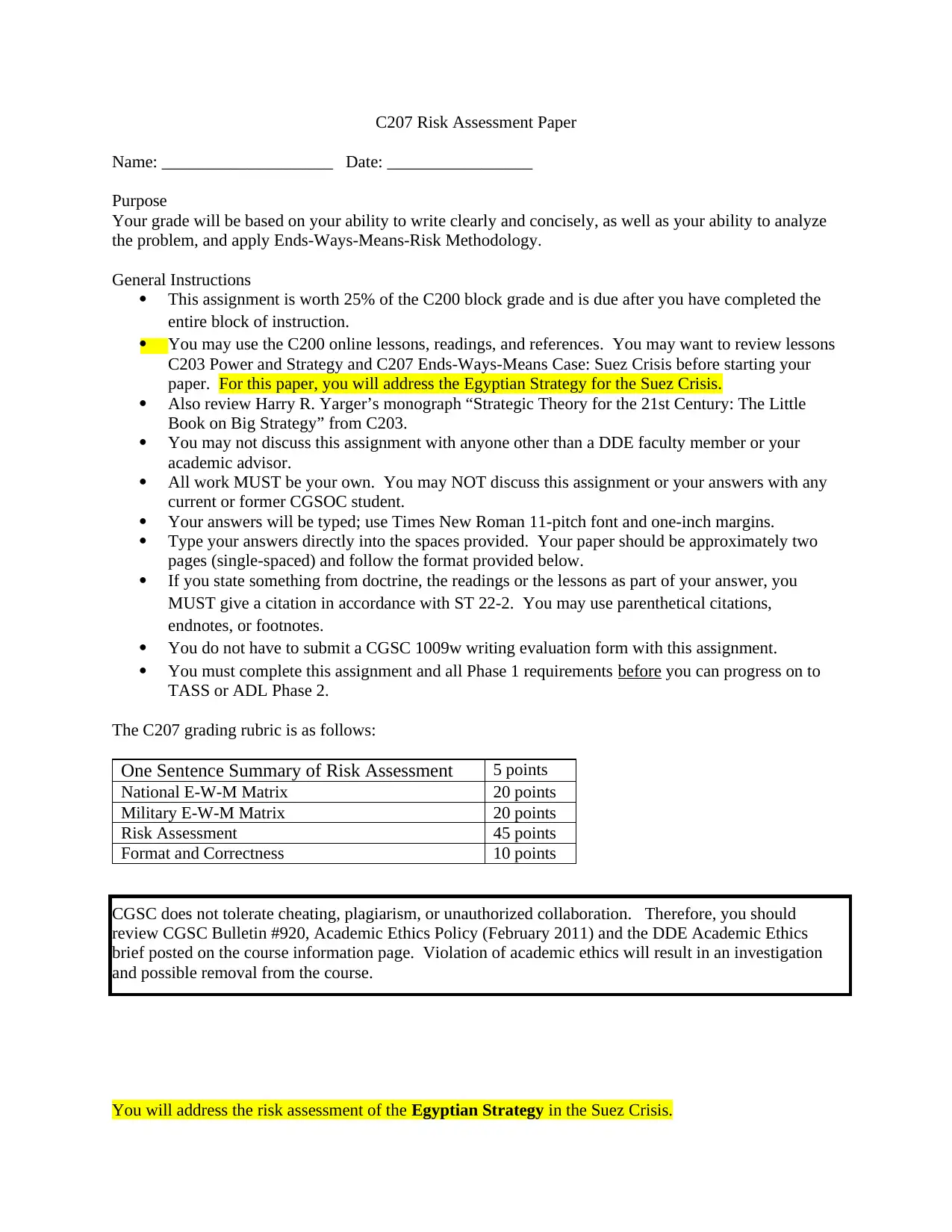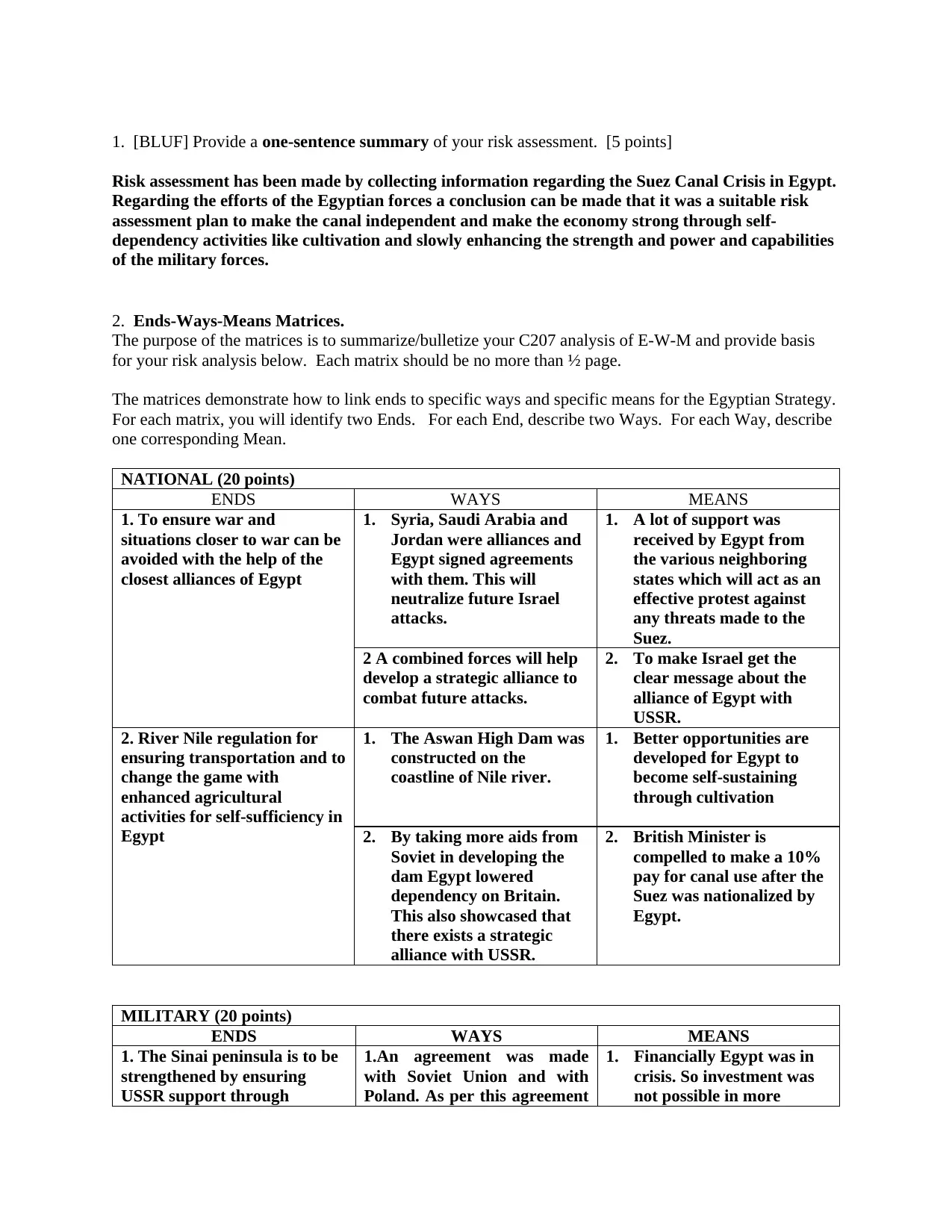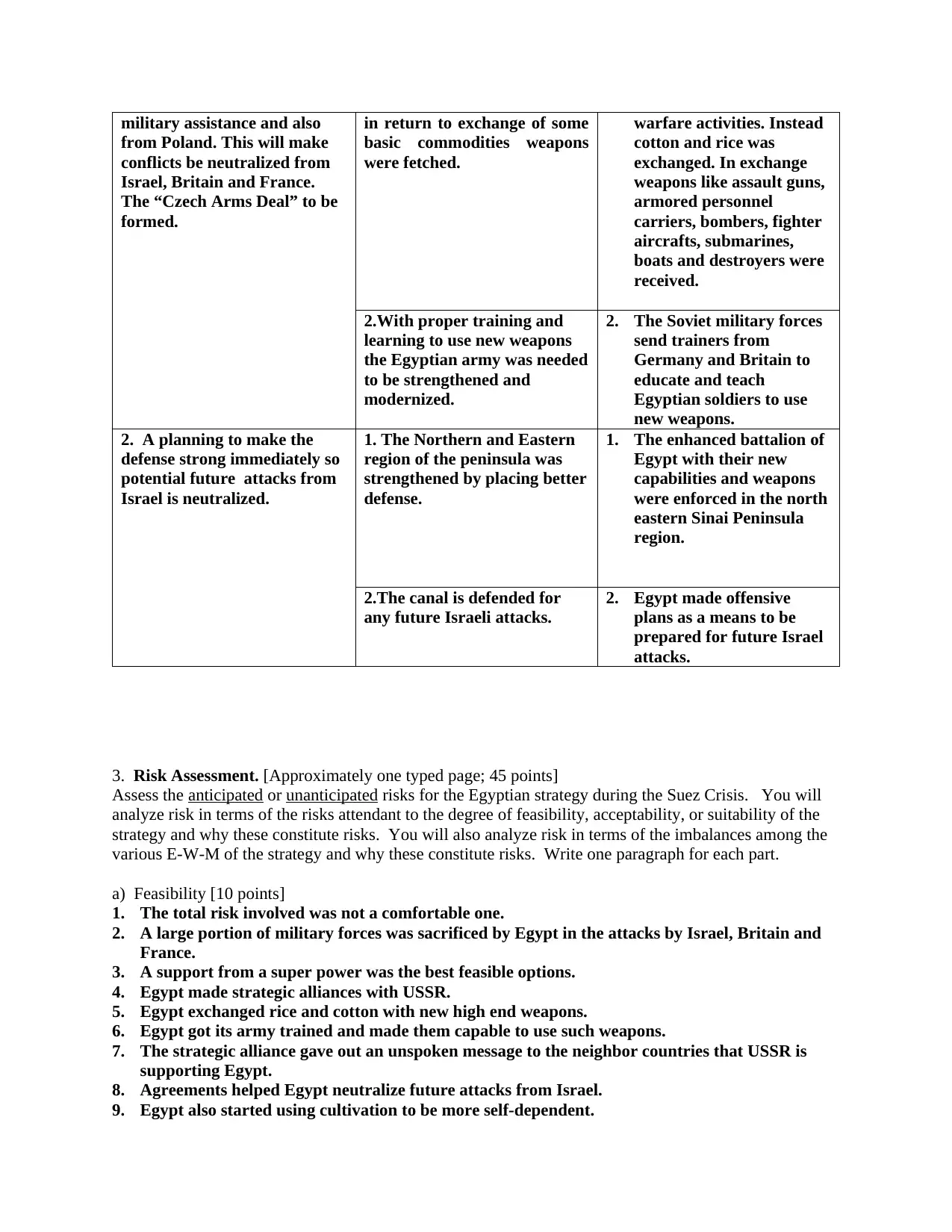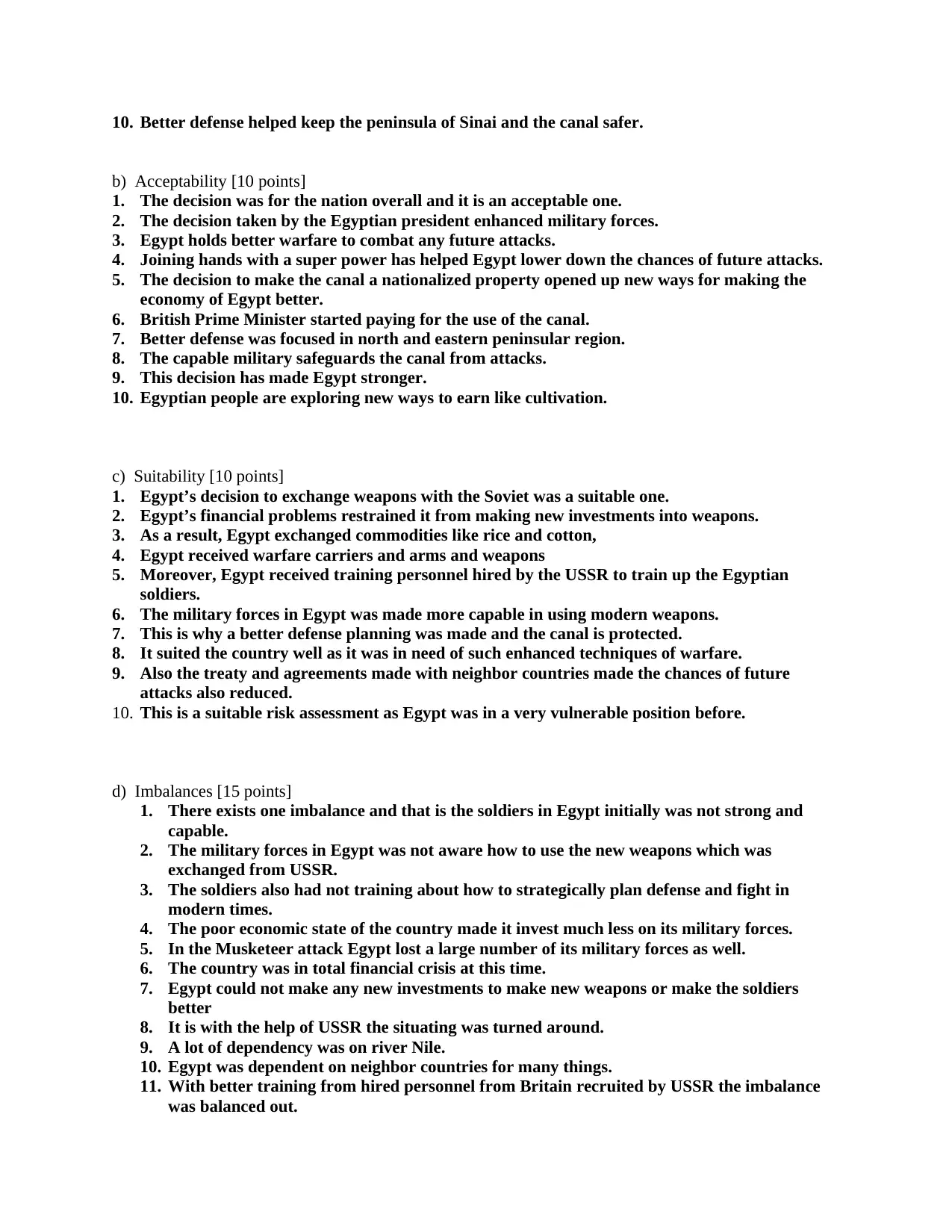C207 Risk Assessment: Analysis of Egyptian Strategy in Suez Crisis
VerifiedAdded on 2020/02/24
|5
|1750
|107
Homework Assignment
AI Summary
This assignment analyzes the Egyptian strategy during the Suez Crisis, focusing on a risk assessment using the Ends-Ways-Means (E-W-M) methodology. The paper begins with a one-sentence summary of the risk assessment and then presents National and Military E-W-M matrices, outlining the ends, ways, and means of the Egyptian strategy. The risk assessment section delves into the feasibility, acceptability, and suitability of the strategy, as well as any imbalances. The analysis highlights the strategic alliances with the USSR, the exchange of commodities for weapons, and the training of Egyptian soldiers. The paper also discusses the risks associated with the initial lack of military preparedness and the economic constraints faced by Egypt. The author concludes that the Egyptian strategy was suitable and helped reduce vulnerabilities.

C207 Risk Assessment Paper
Name: ____________________ Date: _________________
Purpose
Your grade will be based on your ability to write clearly and concisely, as well as your ability to analyze
the problem, and apply Ends-Ways-Means-Risk Methodology.
General Instructions
This assignment is worth 25% of the C200 block grade and is due after you have completed the
entire block of instruction.
You may use the C200 online lessons, readings, and references. You may want to review lessons
C203 Power and Strategy and C207 Ends-Ways-Means Case: Suez Crisis before starting your
paper. For this paper, you will address the Egyptian Strategy for the Suez Crisis.
Also review Harry R. Yarger’s monograph “Strategic Theory for the 21st Century: The Little
Book on Big Strategy” from C203.
You may not discuss this assignment with anyone other than a DDE faculty member or your
academic advisor.
All work MUST be your own. You may NOT discuss this assignment or your answers with any
current or former CGSOC student.
Your answers will be typed; use Times New Roman 11-pitch font and one-inch margins.
Type your answers directly into the spaces provided. Your paper should be approximately two
pages (single-spaced) and follow the format provided below.
If you state something from doctrine, the readings or the lessons as part of your answer, you
MUST give a citation in accordance with ST 22-2. You may use parenthetical citations,
endnotes, or footnotes.
You do not have to submit a CGSC 1009w writing evaluation form with this assignment.
You must complete this assignment and all Phase 1 requirements before you can progress on to
TASS or ADL Phase 2.
The C207 grading rubric is as follows:
One Sentence Summary of Risk Assessment 5 points
National E-W-M Matrix 20 points
Military E-W-M Matrix 20 points
Risk Assessment 45 points
Format and Correctness 10 points
CGSC does not tolerate cheating, plagiarism, or unauthorized collaboration. Therefore, you should
review CGSC Bulletin #920, Academic Ethics Policy (February 2011) and the DDE Academic Ethics
brief posted on the course information page. Violation of academic ethics will result in an investigation
and possible removal from the course.
You will address the risk assessment of the Egyptian Strategy in the Suez Crisis.
Name: ____________________ Date: _________________
Purpose
Your grade will be based on your ability to write clearly and concisely, as well as your ability to analyze
the problem, and apply Ends-Ways-Means-Risk Methodology.
General Instructions
This assignment is worth 25% of the C200 block grade and is due after you have completed the
entire block of instruction.
You may use the C200 online lessons, readings, and references. You may want to review lessons
C203 Power and Strategy and C207 Ends-Ways-Means Case: Suez Crisis before starting your
paper. For this paper, you will address the Egyptian Strategy for the Suez Crisis.
Also review Harry R. Yarger’s monograph “Strategic Theory for the 21st Century: The Little
Book on Big Strategy” from C203.
You may not discuss this assignment with anyone other than a DDE faculty member or your
academic advisor.
All work MUST be your own. You may NOT discuss this assignment or your answers with any
current or former CGSOC student.
Your answers will be typed; use Times New Roman 11-pitch font and one-inch margins.
Type your answers directly into the spaces provided. Your paper should be approximately two
pages (single-spaced) and follow the format provided below.
If you state something from doctrine, the readings or the lessons as part of your answer, you
MUST give a citation in accordance with ST 22-2. You may use parenthetical citations,
endnotes, or footnotes.
You do not have to submit a CGSC 1009w writing evaluation form with this assignment.
You must complete this assignment and all Phase 1 requirements before you can progress on to
TASS or ADL Phase 2.
The C207 grading rubric is as follows:
One Sentence Summary of Risk Assessment 5 points
National E-W-M Matrix 20 points
Military E-W-M Matrix 20 points
Risk Assessment 45 points
Format and Correctness 10 points
CGSC does not tolerate cheating, plagiarism, or unauthorized collaboration. Therefore, you should
review CGSC Bulletin #920, Academic Ethics Policy (February 2011) and the DDE Academic Ethics
brief posted on the course information page. Violation of academic ethics will result in an investigation
and possible removal from the course.
You will address the risk assessment of the Egyptian Strategy in the Suez Crisis.
Paraphrase This Document
Need a fresh take? Get an instant paraphrase of this document with our AI Paraphraser

1. [BLUF] Provide a one-sentence summary of your risk assessment. [5 points]
Risk assessment has been made by collecting information regarding the Suez Canal Crisis in Egypt.
Regarding the efforts of the Egyptian forces a conclusion can be made that it was a suitable risk
assessment plan to make the canal independent and make the economy strong through self-
dependency activities like cultivation and slowly enhancing the strength and power and capabilities
of the military forces.
2. Ends-Ways-Means Matrices.
The purpose of the matrices is to summarize/bulletize your C207 analysis of E-W-M and provide basis
for your risk analysis below. Each matrix should be no more than ½ page.
The matrices demonstrate how to link ends to specific ways and specific means for the Egyptian Strategy.
For each matrix, you will identify two Ends. For each End, describe two Ways. For each Way, describe
one corresponding Mean.
NATIONAL (20 points)
ENDS WAYS MEANS
1. To ensure war and
situations closer to war can be
avoided with the help of the
closest alliances of Egypt
1. Syria, Saudi Arabia and
Jordan were alliances and
Egypt signed agreements
with them. This will
neutralize future Israel
attacks.
1. A lot of support was
received by Egypt from
the various neighboring
states which will act as an
effective protest against
any threats made to the
Suez.
2 A combined forces will help
develop a strategic alliance to
combat future attacks.
2. To make Israel get the
clear message about the
alliance of Egypt with
USSR.
2. River Nile regulation for
ensuring transportation and to
change the game with
enhanced agricultural
activities for self-sufficiency in
Egypt
1. The Aswan High Dam was
constructed on the
coastline of Nile river.
1. Better opportunities are
developed for Egypt to
become self-sustaining
through cultivation
2. By taking more aids from
Soviet in developing the
dam Egypt lowered
dependency on Britain.
This also showcased that
there exists a strategic
alliance with USSR.
2. British Minister is
compelled to make a 10%
pay for canal use after the
Suez was nationalized by
Egypt.
MILITARY (20 points)
ENDS WAYS MEANS
1. The Sinai peninsula is to be
strengthened by ensuring
USSR support through
1.An agreement was made
with Soviet Union and with
Poland. As per this agreement
1. Financially Egypt was in
crisis. So investment was
not possible in more
Risk assessment has been made by collecting information regarding the Suez Canal Crisis in Egypt.
Regarding the efforts of the Egyptian forces a conclusion can be made that it was a suitable risk
assessment plan to make the canal independent and make the economy strong through self-
dependency activities like cultivation and slowly enhancing the strength and power and capabilities
of the military forces.
2. Ends-Ways-Means Matrices.
The purpose of the matrices is to summarize/bulletize your C207 analysis of E-W-M and provide basis
for your risk analysis below. Each matrix should be no more than ½ page.
The matrices demonstrate how to link ends to specific ways and specific means for the Egyptian Strategy.
For each matrix, you will identify two Ends. For each End, describe two Ways. For each Way, describe
one corresponding Mean.
NATIONAL (20 points)
ENDS WAYS MEANS
1. To ensure war and
situations closer to war can be
avoided with the help of the
closest alliances of Egypt
1. Syria, Saudi Arabia and
Jordan were alliances and
Egypt signed agreements
with them. This will
neutralize future Israel
attacks.
1. A lot of support was
received by Egypt from
the various neighboring
states which will act as an
effective protest against
any threats made to the
Suez.
2 A combined forces will help
develop a strategic alliance to
combat future attacks.
2. To make Israel get the
clear message about the
alliance of Egypt with
USSR.
2. River Nile regulation for
ensuring transportation and to
change the game with
enhanced agricultural
activities for self-sufficiency in
Egypt
1. The Aswan High Dam was
constructed on the
coastline of Nile river.
1. Better opportunities are
developed for Egypt to
become self-sustaining
through cultivation
2. By taking more aids from
Soviet in developing the
dam Egypt lowered
dependency on Britain.
This also showcased that
there exists a strategic
alliance with USSR.
2. British Minister is
compelled to make a 10%
pay for canal use after the
Suez was nationalized by
Egypt.
MILITARY (20 points)
ENDS WAYS MEANS
1. The Sinai peninsula is to be
strengthened by ensuring
USSR support through
1.An agreement was made
with Soviet Union and with
Poland. As per this agreement
1. Financially Egypt was in
crisis. So investment was
not possible in more

military assistance and also
from Poland. This will make
conflicts be neutralized from
Israel, Britain and France.
The “Czech Arms Deal” to be
formed.
in return to exchange of some
basic commodities weapons
were fetched.
warfare activities. Instead
cotton and rice was
exchanged. In exchange
weapons like assault guns,
armored personnel
carriers, bombers, fighter
aircrafts, submarines,
boats and destroyers were
received.
2.With proper training and
learning to use new weapons
the Egyptian army was needed
to be strengthened and
modernized.
2. The Soviet military forces
send trainers from
Germany and Britain to
educate and teach
Egyptian soldiers to use
new weapons.
2. A planning to make the
defense strong immediately so
potential future attacks from
Israel is neutralized.
1. The Northern and Eastern
region of the peninsula was
strengthened by placing better
defense.
1. The enhanced battalion of
Egypt with their new
capabilities and weapons
were enforced in the north
eastern Sinai Peninsula
region.
2.The canal is defended for
any future Israeli attacks.
2. Egypt made offensive
plans as a means to be
prepared for future Israel
attacks.
3. Risk Assessment. [Approximately one typed page; 45 points]
Assess the anticipated or unanticipated risks for the Egyptian strategy during the Suez Crisis. You will
analyze risk in terms of the risks attendant to the degree of feasibility, acceptability, or suitability of the
strategy and why these constitute risks. You will also analyze risk in terms of the imbalances among the
various E-W-M of the strategy and why these constitute risks. Write one paragraph for each part.
a) Feasibility [10 points]
1. The total risk involved was not a comfortable one.
2. A large portion of military forces was sacrificed by Egypt in the attacks by Israel, Britain and
France.
3. A support from a super power was the best feasible options.
4. Egypt made strategic alliances with USSR.
5. Egypt exchanged rice and cotton with new high end weapons.
6. Egypt got its army trained and made them capable to use such weapons.
7. The strategic alliance gave out an unspoken message to the neighbor countries that USSR is
supporting Egypt.
8. Agreements helped Egypt neutralize future attacks from Israel.
9. Egypt also started using cultivation to be more self-dependent.
from Poland. This will make
conflicts be neutralized from
Israel, Britain and France.
The “Czech Arms Deal” to be
formed.
in return to exchange of some
basic commodities weapons
were fetched.
warfare activities. Instead
cotton and rice was
exchanged. In exchange
weapons like assault guns,
armored personnel
carriers, bombers, fighter
aircrafts, submarines,
boats and destroyers were
received.
2.With proper training and
learning to use new weapons
the Egyptian army was needed
to be strengthened and
modernized.
2. The Soviet military forces
send trainers from
Germany and Britain to
educate and teach
Egyptian soldiers to use
new weapons.
2. A planning to make the
defense strong immediately so
potential future attacks from
Israel is neutralized.
1. The Northern and Eastern
region of the peninsula was
strengthened by placing better
defense.
1. The enhanced battalion of
Egypt with their new
capabilities and weapons
were enforced in the north
eastern Sinai Peninsula
region.
2.The canal is defended for
any future Israeli attacks.
2. Egypt made offensive
plans as a means to be
prepared for future Israel
attacks.
3. Risk Assessment. [Approximately one typed page; 45 points]
Assess the anticipated or unanticipated risks for the Egyptian strategy during the Suez Crisis. You will
analyze risk in terms of the risks attendant to the degree of feasibility, acceptability, or suitability of the
strategy and why these constitute risks. You will also analyze risk in terms of the imbalances among the
various E-W-M of the strategy and why these constitute risks. Write one paragraph for each part.
a) Feasibility [10 points]
1. The total risk involved was not a comfortable one.
2. A large portion of military forces was sacrificed by Egypt in the attacks by Israel, Britain and
France.
3. A support from a super power was the best feasible options.
4. Egypt made strategic alliances with USSR.
5. Egypt exchanged rice and cotton with new high end weapons.
6. Egypt got its army trained and made them capable to use such weapons.
7. The strategic alliance gave out an unspoken message to the neighbor countries that USSR is
supporting Egypt.
8. Agreements helped Egypt neutralize future attacks from Israel.
9. Egypt also started using cultivation to be more self-dependent.
⊘ This is a preview!⊘
Do you want full access?
Subscribe today to unlock all pages.

Trusted by 1+ million students worldwide

10. Better defense helped keep the peninsula of Sinai and the canal safer.
b) Acceptability [10 points]
1. The decision was for the nation overall and it is an acceptable one.
2. The decision taken by the Egyptian president enhanced military forces.
3. Egypt holds better warfare to combat any future attacks.
4. Joining hands with a super power has helped Egypt lower down the chances of future attacks.
5. The decision to make the canal a nationalized property opened up new ways for making the
economy of Egypt better.
6. British Prime Minister started paying for the use of the canal.
7. Better defense was focused in north and eastern peninsular region.
8. The capable military safeguards the canal from attacks.
9. This decision has made Egypt stronger.
10. Egyptian people are exploring new ways to earn like cultivation.
c) Suitability [10 points]
1. Egypt’s decision to exchange weapons with the Soviet was a suitable one.
2. Egypt’s financial problems restrained it from making new investments into weapons.
3. As a result, Egypt exchanged commodities like rice and cotton,
4. Egypt received warfare carriers and arms and weapons
5. Moreover, Egypt received training personnel hired by the USSR to train up the Egyptian
soldiers.
6. The military forces in Egypt was made more capable in using modern weapons.
7. This is why a better defense planning was made and the canal is protected.
8. It suited the country well as it was in need of such enhanced techniques of warfare.
9. Also the treaty and agreements made with neighbor countries made the chances of future
attacks also reduced.
10. This is a suitable risk assessment as Egypt was in a very vulnerable position before.
d) Imbalances [15 points]
1. There exists one imbalance and that is the soldiers in Egypt initially was not strong and
capable.
2. The military forces in Egypt was not aware how to use the new weapons which was
exchanged from USSR.
3. The soldiers also had not training about how to strategically plan defense and fight in
modern times.
4. The poor economic state of the country made it invest much less on its military forces.
5. In the Musketeer attack Egypt lost a large number of its military forces as well.
6. The country was in total financial crisis at this time.
7. Egypt could not make any new investments to make new weapons or make the soldiers
better
8. It is with the help of USSR the situating was turned around.
9. A lot of dependency was on river Nile.
10. Egypt was dependent on neighbor countries for many things.
11. With better training from hired personnel from Britain recruited by USSR the imbalance
was balanced out.
b) Acceptability [10 points]
1. The decision was for the nation overall and it is an acceptable one.
2. The decision taken by the Egyptian president enhanced military forces.
3. Egypt holds better warfare to combat any future attacks.
4. Joining hands with a super power has helped Egypt lower down the chances of future attacks.
5. The decision to make the canal a nationalized property opened up new ways for making the
economy of Egypt better.
6. British Prime Minister started paying for the use of the canal.
7. Better defense was focused in north and eastern peninsular region.
8. The capable military safeguards the canal from attacks.
9. This decision has made Egypt stronger.
10. Egyptian people are exploring new ways to earn like cultivation.
c) Suitability [10 points]
1. Egypt’s decision to exchange weapons with the Soviet was a suitable one.
2. Egypt’s financial problems restrained it from making new investments into weapons.
3. As a result, Egypt exchanged commodities like rice and cotton,
4. Egypt received warfare carriers and arms and weapons
5. Moreover, Egypt received training personnel hired by the USSR to train up the Egyptian
soldiers.
6. The military forces in Egypt was made more capable in using modern weapons.
7. This is why a better defense planning was made and the canal is protected.
8. It suited the country well as it was in need of such enhanced techniques of warfare.
9. Also the treaty and agreements made with neighbor countries made the chances of future
attacks also reduced.
10. This is a suitable risk assessment as Egypt was in a very vulnerable position before.
d) Imbalances [15 points]
1. There exists one imbalance and that is the soldiers in Egypt initially was not strong and
capable.
2. The military forces in Egypt was not aware how to use the new weapons which was
exchanged from USSR.
3. The soldiers also had not training about how to strategically plan defense and fight in
modern times.
4. The poor economic state of the country made it invest much less on its military forces.
5. In the Musketeer attack Egypt lost a large number of its military forces as well.
6. The country was in total financial crisis at this time.
7. Egypt could not make any new investments to make new weapons or make the soldiers
better
8. It is with the help of USSR the situating was turned around.
9. A lot of dependency was on river Nile.
10. Egypt was dependent on neighbor countries for many things.
11. With better training from hired personnel from Britain recruited by USSR the imbalance
was balanced out.
Paraphrase This Document
Need a fresh take? Get an instant paraphrase of this document with our AI Paraphraser

12. Military forces became more confident and capable.
13. With better planning Egypt made an offensive planning for future.
14. The world got a clear idea that Egypt was no longer vulnerable.
15. USSR was in support of Egypt in case any future attacks occur.
13. With better planning Egypt made an offensive planning for future.
14. The world got a clear idea that Egypt was no longer vulnerable.
15. USSR was in support of Egypt in case any future attacks occur.
1 out of 5
Related Documents
Your All-in-One AI-Powered Toolkit for Academic Success.
+13062052269
info@desklib.com
Available 24*7 on WhatsApp / Email
![[object Object]](/_next/static/media/star-bottom.7253800d.svg)
Unlock your academic potential
Copyright © 2020–2025 A2Z Services. All Rights Reserved. Developed and managed by ZUCOL.




